Akhila Kunche , Ravi Kumar Puli , Sunitha Guniganti , Danaiah Puli
N.I.T. Warangal Andhra Pradesh, India
Correspondence to: Akhila Kunche , N.I.T. Warangal Andhra Pradesh, India.
| Email: |  |
Copyright © 2012 Scientific & Academic Publishing. All Rights Reserved.
Abstract
Effective training is considered as an important factor in determining the efficiency of an organization which depends upon the capability of its employees. For training evaluation to be truly effective, the training and development itself must be appropriate for the person and the situation. Even though evaluation is listed at the last phase, evaluation actually happens during all the phases. It is used during the training process to evaluate the training process itself. Evaluation is not just for the trainer or organization it is absolutely important for the learner too. The purpose of this paper is to provide information to evaluate and improve the effectiveness of training. One new model was found namely Back planning model. Which is same as Kirkpatrick’s model but the process occurs in the reverse order and continues in a cyclic process.
Keywords:
Effective Training, Evaluation
Cite this paper:
Akhila Kunche , Ravi Kumar Puli , Sunitha Guniganti , Danaiah Puli , "Analysis and Evaluation of Training Effectiveness", Human Resource Management Research, Vol. 1 No. 1, 2011, pp. 1-7. doi: 10.5923/j.hrmr.20110101.01.
1. Introduction
1.1. Training
Training can be stated as the methods which are imparted to the employee in fulfilling theorganizationalgoals. Organizations involving in the evaluation of training effectiveness are not only responsible for what the employees learn but they need to see that the knowledge which the employee gained is being applicable in their work performance.so, Training and its regular evaluation would definitely make an organization to stand in the lime light in achieving the objectives. Organizations invest huge amounts for their employee training ex: Infosys and many other MNC’s.
1.2. Key Elements of Training Program Effectiveness
1. Training environment2. Training Design and Development3. Training Delivery 4. Training Implementation5. Training Evaluation
1.2.1. Training Environment
The knowledge and skills of the trainee would also contribute in identifying whether the training process is effective or not. It also depends upon the organization to what extent it supports its employee in the training process. If the company refers to training as basic this won’t yield much results. On the other hand if it refers training as advanced it would make trainees get motivated resulting in good performance.
1.2.2. Training Design and Development
In this stage, the organization should identify the skills and knowledge of the trainee. For this it requires properly designed and developed training. Even though properly designed and developed, the training would go waste for those people who already have knowledge on that job resulting in waste of time.
1.2.3. Training Delivery
This involves some set of activities and methods to evaluate training delivery effectiveness.
1.2.4. Training Implementation
This is in fact a critical step in getting the resources allocated by the management in an effective manner. It addresses some activities and methods which ensures that training to be developed for better performance of the employee.
1.2.5. Training Evaluation
This helps in assessing to what extent the training and development efforts contribute to improved performance and results (it evaluates the employee basing on his performance).Evaluation is the fundamental aspect of good program management at all levels. In the process of evaluation we first need to monitor the things. So both monitoring and evaluation come together.
2. Literature Survey
2.1. Levels of Monitoring and Evaluation Include
Input (resources, supplies, staff)Process (activities)Output (services knowledge)Outcome (risk behavior, handling the situations)
2.2. Purpose of Training Evaluation
The five main purposes of training are:Feedback: It helps in giving feedback to the trainees by defining the objectives and linking it to their learning outcomes and performance.Research: It helps in finding out the relationship between acquired knowledge, transfer of knowledge at the work place, and trainingControl program: It helps in controlling the training program because if the training is not effective then it can be dealt with accordingly with some advancement.Power games: At times, the top management (higher authoritative employee) uses the evaluative data to manipulate it for their own benefits.Intervention: It helps in determining that whether the actual outcomes are matched with the expected outcomes.
2.3. Process of Training Evaluation
Before Training: The learner's (trainees) skills and knowledge are assessed before the training program itself. In the initial stage of training, candidates generally consider it as a waste of resources because most of the times they are unaware of the objectives and learning outcomes of the program. Once aware, they are asked to give their opinions on the methods used and whether those methods are preferred and applicable of their learning style.During Training: It is the phase at which instruction is started. This phase usually consist of short tests at regular intervals and monitoring their daily performances.After Training: It is the phase when learner’s skills and knowledge are assessed again to measure the effectiveness of the training. This phase is designed to determine whether training has had the desired effect at individual department and organizational levels. There are various evaluation techniques for this phase
3. Techniques of Evaluation
The various methods of training evaluation are: ObservationQuestionnaire InterviewObservations: The work behavior of the trainees is observed before, during and after the training. The trained observer observes and records the behavior of the trainees. The evaluation would be regarding communication and speaking, presentation skills, time management and productivity, customer service, negotiation, creativity and critical thinking etc.Questionnaire: It consists of some questions in the form of multiple choices or rating scales which would be given to both the trainer and learner. In some cases this would also be given to the supervisors in order to evaluate the effectiveness of training regarding the learner.Interview: Interviews can be either structured or unstructured. Structured interviews consist of predetermined questions where as unstructured questions starts with basic questions and would go on depending on the interviewer in response of the learner. Though it is time consuming it gives the exact mind map of what the learner thinks. at times interviews can also be done in groups of 5-12 in order to obtain qualitative information.
4. on Temporary Training and Development Techniques
As there is always a scope for continuous development, several training methods have proven highly effective and are widely accepted in improving the Technical Skills and communication skills of the employee. These training methods include on-the-job training, role playing, self- instruction, team building games and simulations, computer-based training, mentoring, and job rotation. Any further development to these methods would yield good results.
4.1. On-The-Job Training
This is one of the most common and least expensive training and development techniques which is followed by most of the organizations. On job training is the process of learning skills while working where the employees obtain the knowledge and skills for the completion of their tasks through a systematic training program. Research indicates that employees gain approximately 80 percent of their work-related knowledge and skills on the job itself. Structured OJT involves having an experienced employee train a new employee at the work site and having the new employee receive feedback, advice, and suggestions from coworkers and trainers. Implementing a structured OJT program involves five basic steps:(1) Analyzing the tasks and skills to be learned(2) Selecting, training and supervising trainers.(3) Preparing training materials.(4) Conducting an OJT program; and(5) Evaluating the program and making any necessary improvements or modifications.
4.2. Role Playing
In role playing, trainees are put into various roles and play out that role within a group in order to learn and practice ways of handling different situations. A trainer creates a scenario that is to be acted out by the trainees and is guided accordingly by the trainer. Here the trainees receive immediate feedback from the trainer and this helps them allowing better understanding of their own behavior.
4.3. Self-Instruction
Self-instruction refers to an instructional method that emphasizes on individual learning. In self-instruction programs, the employees take the responsibility for their own learning. This helps the trainees to have a great control over topics, the sequence of learning, and the pace of learning. Forms of self-instruction include programmed learning, individualized instruction, personalized systems of instruction, learner-controlled instruction, and correspondence study. For self-instruction programs to be successful, employers must not only make learning opportunities available, but also must promote interest in these learning opportunities. Self-instruction allows trainees to learn at their own pace and receive immediate feedback. This method also benefits companies that have to train only a few people at a time.
4.4. Team Building
Team building is the creation and maintenance of effective work groups with possesses similar goals and objectives. Team building is a formal process of building work teams with objectives and goals, facilitated by a third-party consultant. Every individual working in teams share the work equally. Team building provides a structured, guided process whose benefits include a greater ability to manage complex projects and processes, flexibility to respond to changing situations, and greater motivation among team members.
4.5. Games and Simulations
Games and simulations are structured competitions and operational models used as training situations to reflect the real-life scenarios. The benefits include improvement of problem-solving and decision-making skills, a greater understanding of the organization the ability to study actual problems, and the power to capture the trainee’s interest.
4.6. Computer-Based Training
In computer-based training (CBT), computers and computer-based instructional materials act as the primary medium of instruction. Computer-based training programs are designed to facilitate the learning process for the student. Primary uses of CBT include instruction in computer hardware, software, and operational equipment. The last is of particular importance because CBT can provide the student with a simulated experience of operating a particular piece of equipment or machinery while eliminating the risk of damage to costly equipment by a trainee. The use of computer-based training enables a training organization to reduce training costs, while improving the effectiveness of the training.
4.7. Mentoring
Mentoring refers to programs in which companies select mentors also called advisers, counselors, and role models—for trainees or let trainees choose their own. When trainees have questions or need help, they turn to their mentors, who are experienced workers or managers with strong communication skills. Mentors offer advice not only on how to perform specific tasks, but also on how to succeed in the company, how the company's corporate culture and politics work, and how to handle delicate or sensitive situations. Furthermore, mentors provide feedback and suggestions to assist trainees in improving inadequate work.
4.8. Job Rotation
Through job rotation, companies can create a flexible workforce capable of performing a variety of tasks and working for multiple departments or teams if needed. Furthermore, employees can cultivate a holistic understanding of a company through job rotation and can learn and appreciate how each department operates. Job rotation duties encompass typical work performed under the same conditions as the employees of the departments experience. Because of the value some companies place on job rotation, they establish permanent training slots in major departments, ensuring ongoing exposure of employees to new tasks and responsibilities.
4.9. Performance Appraisal
Appraisal is the evaluation of worth, quality or merit. In the organizations context it is the systematic evaluation of personnel by superiors or others familiar with their performance. The role of performance appraisals is not limited only to make decisions about salary increase but it helps to arrive at many decisions which include: salary increase, Promotion, Training and Development, Feedback, Pressure on Employees.
5. Kirkpatrick’s Four – Level Training Evaluation Model
This is the best method for evaluating the training effectiveness and widely accepted and followed by many organizations. Kirkpatrick's Training Evaluation Model consists of Four-Levels. According to this model evaluation should always start from the basic level and further evaluation of other levels would be done basing on the need for the situation. The four levels include:Reaction - This determines how the reaction of the trainees during the training process.Learning - the extent to which the learners gain knowledge and skillsBehavior - capability to perform the learned skills while on the jobResults - includes such items as monetary, efficiency, moral, etc.There are three problematic assumptions of the Kirkpa- trick model: 1) the levels are not arranged in ascending order, 2) the levels are not causally linked, and 3) the levels are positively inter-correlated.
6. New Model
6.1. Backwards Planning
Many organizations consider this to be an old model as it is not properly arranged so here we come out with a new plan called “Backwards planning”. | Figure 1. The backwards planning model |
Thus, planning and analysis needs to work backward by identifying: The desired impact (outcome or result) that will improve the performance of the businessThe level of performance the learners must be able to do to create the impactThe knowledge and skills they need to learn in order to performWhat they need to perceive in order to learn (the need to learn).
6.1.1. Reaction
This states the reaction of the employees towards the training. This level measures the learner’s perception of the course. Learners here are aware of what they are supposed to do in order to accomplish their task. This level is not indicative of the training's performance potential but it helps the employees to get motivated to engage in achieving their goals. When a learning package is first presented, rather it be e-learning, classroom training, CBT, etc., the learner has to make a decision as to whether he or she will pay attention to it. This differs somewhat from Kirkpatrick (1996) who writes, “Reaction may best be considered as how well the trainees liked a particular training program.”
6.1.2. Learning
This learning process helps the employees in changing their attitudes &mindset in order to make them improve knowledge and increase skills as a result of participation. Measuring the learning that takes place in a training program is important in order to validate the learning objectives. Evaluating the learning that has taken place typically focuses on such questions as: What knowledge was acquired?What skills were developed or enhanced?What attitudes were changed?Learner assessments are created to allow a judgment to be made about the learner's capability for performance. Assessment and Evaluation are completely different where Assessment is about the progress and achievements of the individual learners, while evaluation is about the learning program as a whole.
6.1.3. Performance
This involves in testing the students capabilities to perform learned skills while on the job, rather than in the classroom. In Kirkpatrick's original four-levels of evaluation, he names this level behavior. However, behavior is the action that is performed, while the final result of the behavior is the performance. This is an important factor to be measured as the primary purpose of training is to improve results by having the students learn new skills and knowledge and then actually applying them to the job.
7. Results
This is the final results that occur. It measures the effectiveness of the training program. That is, “What impact has the training achieved?” These impacts can include such items as monetary, efficiency, moral, teamwork, etc. As we move from level one to level four, the evaluation process becomes more difficult and time-consuming; however, the higher levels provide information that is of increasingly significant value.Planning it backwards will help to ensure there is a circular causality:  | Figure 2. Circular causality of backwards planning |
8. Survey
This survey was done in a software company. The organization assesses its training methods and develops a robust and effective practice.The following are the courses offered in the training program: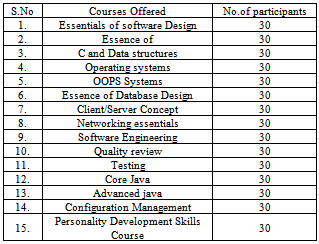 The survey was conducted on a sample of 30 associates. Feedback from the trainees on the training in each individual course and on the overall training was taken from the associates.
The survey was conducted on a sample of 30 associates. Feedback from the trainees on the training in each individual course and on the overall training was taken from the associates.
8.1. Questionnaire on Effectiveness of Training on Each Course
Given below are some statements. Indicate your opinion on the statement in the rating scale of 5 to 1 based on your experience. The rating scale:5- Excellent4-Very Good3-Good2-Poor1-very poorFeedback form: This has filled by the trainees after the completion of each course during the training program. Trainee ID: Trainee NameCourse Code: nstructor Name: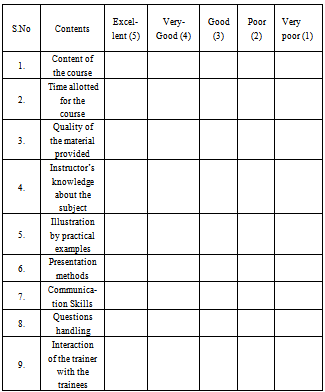 Three learning’s from the course:
Three learning’s from the course: Comments/Suggestions:
Comments/Suggestions: To evaluate the effectiveness of overall training, a questionnaire has been collected from the associates after the completion of 3-months training:
To evaluate the effectiveness of overall training, a questionnaire has been collected from the associates after the completion of 3-months training: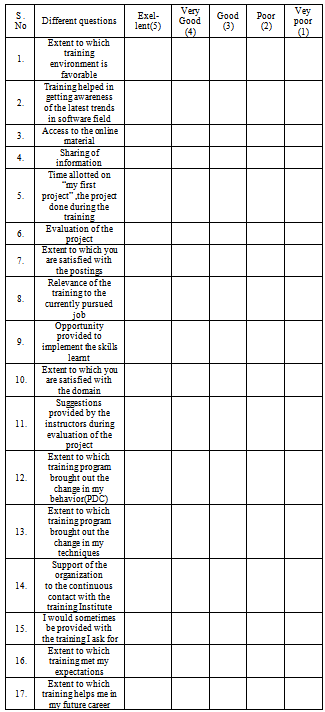
9. Results
Responses For the questionnaire: | Figure 3. The content of the course |
 | Figure 4. Time allotted for the course |
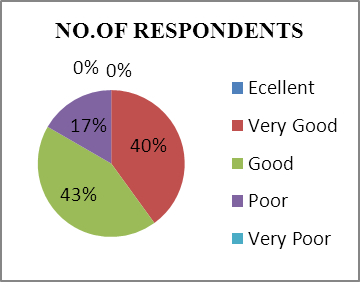 | Figure 5. Quality of the Material Provided |
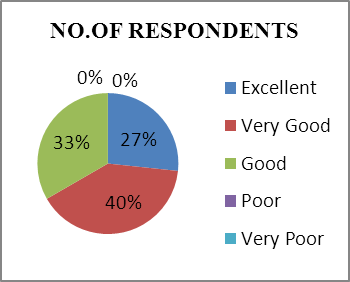 | Figure 6. Instructors Knowledge about the Subject |
 | Figure 7. Illustration by practical examples |
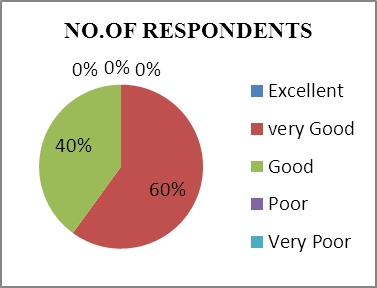 | Figure 8. Presentation methods |
 | Figur 9. Communication skills |
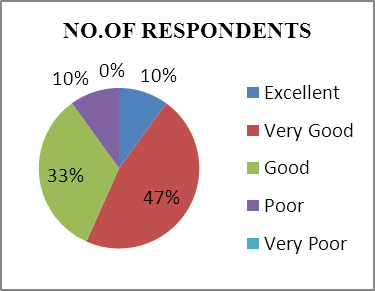 | Figure 10. Questions handling |
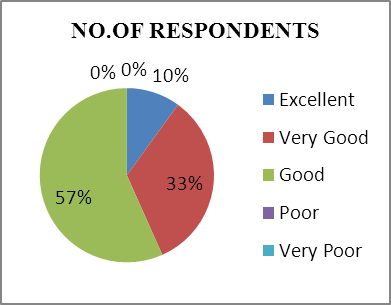 | Figure 11. Interaction Of the trainer with the trainee |
10. Conclusions
This(Back planning) causality should continue in a circular fashion in that the results achieved should now drive the performers' perceptions of the need to learn more and perform better in order to achieve even better results. Of course this assumes that not only the customer understands the level of impact achieved, but also the performers/learners' perception on how close they came to achieving the desired result. From the above feedback the conclusions that were drawn include:1. Training environment is favorable.2. Material provided was good.3. Training offered a mix of pedagogical and technological experience to deliver effective solutions.4. The learning phase is evaluated by conducting test before and after training.
References
| [1] | Kirkpatrick, D. L. (1975). Techniques for Evaluating Training programs.Evaluating training programsD. L. Kirkpatrick (ed.) Alexandria, VA: ASTD |
| [2] | Craig, Robert L., ed. Training and Development Handbook: A Guide to Human Resource Development. 3rd edition. New York: McGraw-Hill, 1987 |
| [3] | Alliger, G. M., Janak, E. A. (1989). Kirkpatrick's levels of training criteria: Thirty years later. Personnel Psychology, 42 (2), 331-342 |
| [4] | Bushnell, D. S. (1990). Input, processing, output: A model for evaluating training. Training and Development, 44(3), 41-43 |
| [5] | Jacobs, Ronald L., and Michael J. Jones. Structured On-the- Job Training.San Francisco: Berret-Koehler Publishers, 1995 |
| [6] | Schalock, R. (2001). Outcome based evaluations (2nd edition). Boston: Kluwer Academic/Plenum |
| [7] | Stufflebeam, D. L. (2001). Evaluation models.San Francisco: Jossey-Bass |
| [8] | Evaluation Techniques that work, Training and development journal |
| [9] | Boehle, S. (2006). Are You Too Nice to Train? Training Magazine.Retrieved from web Feb. 8, 2009 |
| [10] | Human Resource Management- T.N.Chhabra |



 The survey was conducted on a sample of 30 associates. Feedback from the trainees on the training in each individual course and on the overall training was taken from the associates.
The survey was conducted on a sample of 30 associates. Feedback from the trainees on the training in each individual course and on the overall training was taken from the associates. Three learning’s from the course:
Three learning’s from the course: Comments/Suggestions:
Comments/Suggestions: To evaluate the effectiveness of overall training, a questionnaire has been collected from the associates after the completion of 3-months training:
To evaluate the effectiveness of overall training, a questionnaire has been collected from the associates after the completion of 3-months training:









 Abstract
Abstract Reference
Reference Full-Text PDF
Full-Text PDF Full-Text HTML
Full-Text HTML